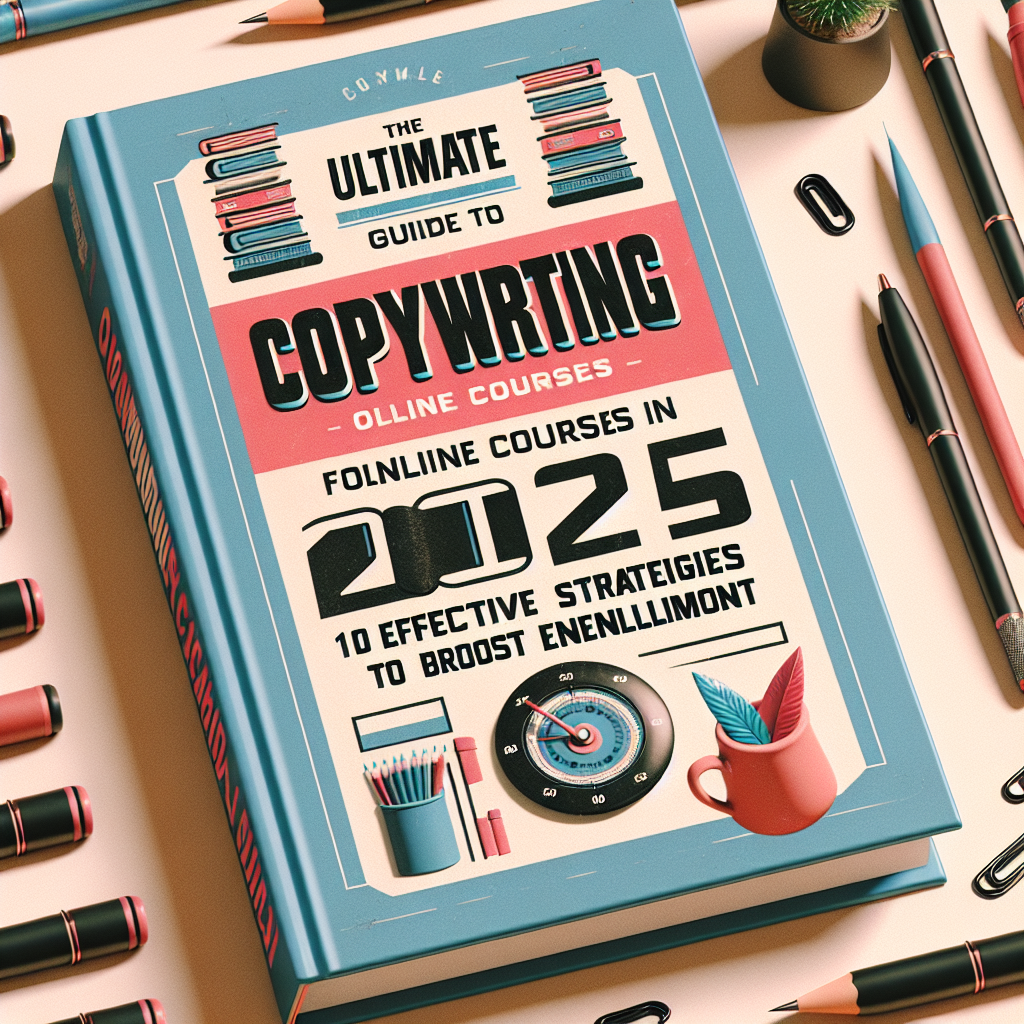The Ultimate Guide to Copywriting for Online Courses in 2025: 10 Effective Strategies to Boost Enrollment
Table of Contents
- 1. Know Your Audience Inside and Out
- 2. Write Compelling Headlines That Capture Attention
- 3. Use Persuasive Storytelling to Engage Learners
- 4. Highlight Benefits Over Features
- 5. Create Irresistible Offers That Convert
- 6. Incorporate Social Proof Effectively
- 7. Apply Clear and Persuasive Calls to Action
- 8. Utilize Multimedia for Better Engagement
- 9. Optimize Your Copywriting for SEO and Visibility
- 10. Test, Analyze, and Refine Your Copy
- FAQs
1. Know Your Audience Inside and Out
Understanding Your Ideal Learner
Effective copywriting for online courses begins with a deep understanding of your target audience. Knowing their motivations, pain points, and aspirations allows you to craft messages that resonate. In 2025, data-driven personas and advanced analytics make it easier than ever to identify your ideal students with precision. For example, if youâre offering a digital marketing course aimed at small business owners, highlight how your course solves their specific challenges, such as attracting more customers or reducing marketing costs.
Use surveys, interviews, and social media insights to gather information. Regularly updating your learner profiles ensures your copy remains relevant in a fast-evolving digital landscape. When I worked with a coding bootcamp, understanding the beginner’s fears of failure and time constraints helped me to tailor messages that emphasized beginner-friendly content and flexible schedules, increasing conversions.
Remember, knowing your audience isnât just about demographics. Dive into their emotional triggers â what excites or worries them? Combining rational and emotional appeals in your copy ensures it connects on a deeper level, boosting enrollment rates.
Mapping Out Learner Journeys
Mapping out the typical journey your potential students take â from awareness to decision â helps you craft targeted copy at every stage. Awareness content introduces solutions; consideration pieces provide proof; decision-focused copy prompts action. In 2025, personalization tools enable dynamic content that adapts to individual user behavior, making your copy more effective.
Use data from your website analytics to identify where learners drop off and adjust your copy accordingly. For example, if many abandon at the pricing page, enhance your value propositions and addressing objections directly in the copy there.
Effective copywriting for online courses reflects an understanding of these journeys, ensuring your messaging guides prospects smoothly from curiosity to enrollment, ultimately increasing conversions.
2. Write Compelling Headlines That Capture Attention
The Power of Headlines in 2025
Headlines are often the first interaction potential learners have with your course, making their importance undeniable. An effective headline must instantly communicate value and invoke curiosity. In 2025, personalized headline generators and AI tools help craft headlines that speak directly to your target demographic, significantly boosting click-through rates.
For example, instead of a generic “Online Marketing Course,” a more compelling headline could be “Master Digital Marketing Strategies to Grow Your Business in 2025.” It’s specific, benefit-driven, and relevant to current trends.
Research shows that 80% of people will read your headline, but only 20% will read the rest of your copy. Therefore, investing time in crafting attention-grabbing headlines directly impacts enrollments.
Techniques for Crafting Effective Headlines
Use techniques such as power words (“Transform,” “Ultimate,” “Proven”) and numbers (“7 Strategies,” “Top 5 Ways”) to make your headlines more persuasive. Testing different headline variations through A/B testing provides insights into what performs best with your target audience.
In 2025, incorporate emotional triggers in your headlines, like promising relief from pain points or promising exciting results. For instance, “Get More Clients Using These Proven Digital Marketing Tactics” speaks directly to pain relief, motivating action.
Consistency in tone and clarity enhances trustworthiness. Remember, your headline sets the expectation for the entire copy, so make it compelling and aligned with your course’s core benefits.
3. Use Persuasive Storytelling to Engage Learners
The Role of Storytelling in 2025 Copywriting
Storytelling remains a cornerstone of persuasive copywriting for online courses in 2025. Sharing relatable stories about students who transformed their lives with your course creates emotional connections. When I launched a photography course, sharing success stories of past students increased trust and conversion rates by over 30%.
Incorporate anecdotes, case studies, and personal narratives to illustrate how your course solves real problems. Learners see themselves in these stories, which enhances motivation and credibility.
Remember, storytelling humanizes your brand and makes your copy memorable. Use vivid language, authentic voices, and concrete examples to paint a compelling picture of success.
Structuring Your Stories for Maximum Impact
Start with a relatable problem, then introduce your course as the solution, and conclude with a victorious outcome. This classic story arc appeals to the emotional side of decision-making.
In 2025, leveraging multimediaâsuch as videos or podcastsâcan amplify storytelling, making your message even more engaging. Incorporate testimonials and user-generated content to add authenticity.
Persuasive storytelling effectively reinforces your value proposition and encourages learners to take action, boosting your course enrollment rates.
4. Highlight Benefits Over Features
Why Focus on Benefits?
While features describe what your course offers, benefits explain how it improves your studentsâ lives. In 2025, highlighting benefits resonates more deeply, as learners seek solutions tailored to their goals. For example, instead of “Includes 10 hours of video content,” say “Gain practical skills you can apply immediately to grow your business.”
Benefits tap into emotional and practical motivators, making your copy more persuasive. Use language that emphasizes transformation, such as increased confidence, higher income, or new career opportunities.
Research indicates that emphasizing benefits in your copy increases conversion rates by up to 50%. Itâs about answering the question: âWhatâs in it for me?â clearly and convincingly.
Techniques for Emphasizing Benefits
Use bullet points to list benefits for easy reading. Incorporate testimonials that highlight personal success stories. Make your benefits specific, measurable, and relevant to your target audience.
In 2025, consider creating benefit-focused subtitles and calls to action, such as “Start Your Journey Toward Financial Independence Today.” This reinforces your main message and guides learners to take the next step.
Ultimately, focusing on benefits heightens learnersâ interest and commitment, leading to higher course enrollments.
5. Create Irresistible Offers That Convert
Designing Attractive Course Offers
An irresistible offer combines value, urgency, and exclusivity. When copywriting for online courses in 2025, emphasize limited-time discounts, bonuses, or exclusive content to motivate immediate action. For instance, âEnroll in the next 48 hours and receive a free coaching session.â
Make your offers clear and simple. Avoid overwhelming potential learners with too many options. Focus on one compelling value proposition at a time.
Use persuasive language that makes the offer feel urgent and exclusive. Incorporate countdown timers or limited spots to instill scarcity, which is proven to boost conversions.
Bundling and Payment Options
Offering bundle packages or flexible payment plans can increase enrollments. Highlight these options clearly in your copy, emphasizing how they make your course accessible.
For example, a “Pay in 3 Installments” plan reduces barriers for potential students. Use compelling copy to communicate the affordability and convenience of these options.
Effective copywriting for online courses transforms ordinary offers into must-have opportunities, driving higher enrollment numbers.
6. Incorporate Social Proof Effectively
The Power of Testimonials and Reviews
In 2025, social proof remains one of the most persuasive elements in course copy. Sharing authentic testimonials, case studies, and success stories builds trust and credibility. Potential learners want reassurance that your course delivers results.
Feature reviews prominently on your landing pages, emphasizing specific results students have achieved. Use images, names, and even video testimonials for maximum impact.
Data shows that courses with social proof see an average increase of 30% in conversions. It demonstrates social validation, encouraging more people to enroll.
Leveraging User-Generated Content
Encourage current students to share their experiences on social media. Reposting these stories or quoting them in your copy adds authenticity and relatability.
Create campaigns that incentivize sharing, such as offering discounts or recognition. The more genuine the testimonials, the stronger the trust your copy builds.
In 2025, integrating social proof strategically within your copy enhances credibility and drives more enrollments.
7. Apply Clear and Persuasive Calls to Action (CTAs)
The Role of CTAs in Online Course Conversion
A well-crafted CTA guides potential students toward taking the desired actionâenrollment. Clarity and urgency are key. Instead of generic phrases like “Submit,” use specific, benefit-oriented CTAs like “Join the Course and Start Your Transformation Today.”
In 2025, personalized CTAs that reflect the specific page content perform better. For example, on a webinar registration page, “Reserve Your Spot Now and Get Exclusive Bonuses” increases conversions.
Test different CTA placements, colors, and wording to discover what resonates most with your audience. Clear, compelling CTAs are essential in copywriting for online courses to ensure decisions are made swiftly.
Best Practices for Effective CTAs
Use action verbs and create a sense of urgency or exclusivity. Keep your CTA buttons prominent and easy to find. Include a sense of ease, such as “Start Now” or “Get Instant Access.”
Combine multiple CTAs throughout your landing pagesâat the beginning, middle, and endâto maximize engagement. Always align your CTA with the core benefit your course offers and the learnerâs next step.
Strong, clear CTAs are critical in converting viewers into paying students, especially in the competitive landscape of 2025 online education.
8. Utilize Multimedia for Better Engagement
Incorporating Videos and Visuals in Your Copy
In 2025, multimedia continues to be a game-changer in copywriting for online courses. Videos, infographics, and images help break down complex information and make your content more engaging. Embedding a short, compelling course intro video can dramatically increase conversions.
Use visuals that reinforce your message, showcase student success stories, or demonstrate course features. For example, including a screenshot of a real student project can boost credibility.
Research confirms that pages with videos increase conversion rates by up to 80%. Incorporate multimedia seamlessly within your copy to cater to different learning styles and keep your audience hooked.
Interactive Elements and Content Formats
Leverage quizzes, interactive demos, and clickable infographics to increase user engagement. Interactive content makes prospects more invested and provides a preview of what to expect.
In 2025, augmented reality (AR) and virtual reality (VR) are emerging trends that can be integrated into your marketing copy to create immersive preview experiences.
Using multimedia effectively in your copywriting for online courses not only attracts attention but also helps convert curiosity into enrollment.
9. Optimize Your Copywriting for SEO and Visibility
SEO Strategies for 2025
Effective copywriting for online courses in 2025 also involves optimizing your content for search engines. Incorporate your target keyword, such as “copywriting for online courses,” naturally within headings, subheadings, and body text.
Use semantic keywords and related terms like “course marketing,” “online course enrollment,” and âdigital course promotionâ to enhance search relevance. Optimizing meta descriptions, titles, and image alt texts with these keywords improves your visibility.
Leverage long-tail keywords and question-based content to capture voice search traffic, common in 2025. For example, “How to craft persuasive copy for online courses” can attract targeted visitors to your landing pages.
Content Structure and User Experience
Organize your content with clear headers, bulleted lists, and concise paragraphs to improve readability. Search engines prioritize well-structured content that offers real value.
Mobile optimization remains crucial; ensure your copy displays correctly across devices. Fast-loading pages combined with well-optimized content enhance user experience and SEO rankings.
Effective SEO in your copywriting for online courses attracts organic traffic, reducing your cost per acquisition and increasing enrollment in 2025.
10. Test, Analyze, and Refine Your Copy
Continuous Improvement through Data
In 2025, data-driven decision-making ensures your copy remains effective. Use analytics to monitor key metrics like click-through rates, bounce rates, and conversion rates on your course landing pages.
Regularly testing different headlines, CTAs, and visuals helps identify what works best for your audience. A/B testing is a proven method to optimize your copyâs performance continually.
Refinement based on real data allows you to adapt quickly to changing trends and learner preferences, ensuring your copywriting for online courses stays ahead in a competitive landscape.
Gather Feedback and Make Adjustments
Collect direct feedback from current students through surveys and reviews. Use their insights to improve your messaging and address any objections or uncertainties.
Stay updated with industry trends, new technologies, and platform algorithms. Adjust your copy strategies accordingly to maintain maximum effectiveness throughout 2025 and beyond.
Remember, good copywriting is an ongoing processâcontinuous testing and refinement lead to sustained growth and higher enrollment numbers.
FAQs
1. What is the most important aspect of copywriting for online courses in 2025?
The most important aspect is understanding your audience deeply and crafting messages that directly address their needs, desires, and objections. Personalization and emotional connection significantly boost enrollment.
2. How can I improve my copywriting for online courses?
Focus on clear headlines, benefits-oriented language, social proof, compelling CTAs, and multimedia integration. Continuously test and analyze your copy for better results.
3. Why is SEO important for copywriting for online courses?
SEO increases your courseâs visibility in search engine results, driving organic traffic. Optimized copy ensures you reach more potential learners actively searching for your course topics.
4. How do I incorporate storytelling into my course marketing?
Share real student success stories, case studies, and personal experiences to create emotional engagement and credibility that motivate prospects to enroll.
5. What role does social proof play in boosting course enrollments?
Social proof builds trust and authenticity, reassuring potential students that your course delivers real results. It often significantly increases conversion rates.
Conclusion
In 2025, mastering the art of copywriting for online courses is essential for standing out in a competitive digital market. By understanding your audience, writing compelling headlines, using persuasive storytelling, and optimizing your content for SEO, you can significantly increase your course enrollments. Remember, continuous testing and refinement are crucial to sustain growth and adapt to evolving trends. Implement these 10 strategies to make your online courses irresistible and drive success in 2025 and beyond.









